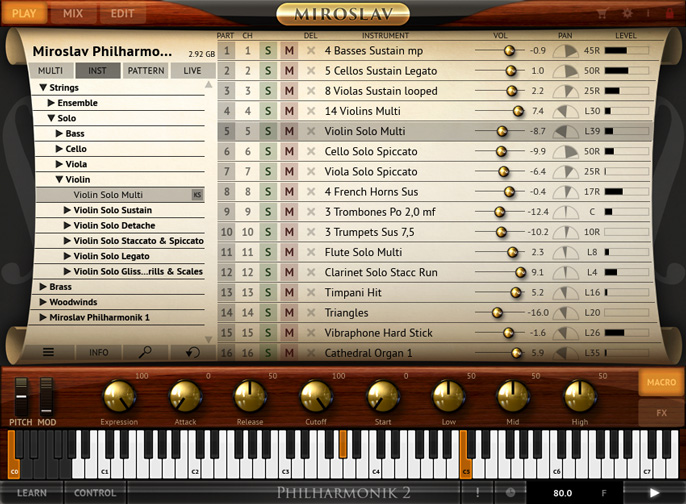
IK Multimedia has released Miroslav Philharmonik 2, a major update to its orchestral workstation app for Mac & Windows.
With Miroslav Philharmonik 2 you get a complete selection of expressive sounds that includes strings, woodwinds and brass, plus a 9’ concert grand piano, a harpsichord, orchestral chimes, a concert marimba, a vibraphone and a glockenspiel. Plus, you get all the samples from the original Miroslav Philharmonik library, updated with articulation switching and the updated effects.
Features:
- Over 55GB of samples
- Includes the complete original Miroslav Philharmonik sound library optimized for more control with articulation switching and enhanced macros
- Recorded and produced by jazz legend Miroslav Vitous
- Over 2,700 stereo instruments that cover the complete orchestral spectrum and more
- Multiple articulations per instrument with articulation switching
- Comes with ConvoRoom convolution reverb with 3D GUI
- 34 studio effects from SampleTank 3
- 4 mastering processors from T-RackS
- Multi-channel mixer-like Mix interface with 16 channels and 4 insert effects per channel, 4 stereo effect returns (with 5 insert effects each) and a master channel with 5 insert effects
- Access to the instrument Edit page with 3 sample engines (including formant preserving pitch-shifting and time-stretching engines), 10 filter types and 8 macro controls per instrument for quick multi-parameter editing
- Based on SampleTank 3’s powerful 64-bit engine
- Recorded at CNSO Studios in Prague
Miroslav Philharmonik 2 is available now for US $399 (normally $499). Upgrade and crossgrade offers are also available.

Though $400 might seem like a bargain for a full orchestra library, make sure you listen to the demos (all of them). You’ll learn things about this set (and its shortcomings).
I do think the strings sound pretty playable, but not super “lush” sounding compared to other high-dollar libraries.
The brass and woodwinds samples suffer from the issue of just not choosing very playable attacks. When you ask a woodwind player or brass player to play a long note, they will instinctively attack the note differently than they would if they were playing a melodic passage with more movement. That’s why these samples sound strange in the demos. I think other developers (with more experience) know to keep this in mind during the recording phase, so that when they are mapped, you don’t hear each note with a little swell on each attack.
Even at this price, I’d suggest doing a little research and checking out the competition before you blow $400 (or some competitive upgrade price) on this.
Since there are for example different choices of voicings and articulations for each of most of the instruments, I’m not quite sure the above observations are quite as valid stub. For example, I’ve just been messing around with the clarinet, investigating the differences between staccato, sustain and multi and each of them has different attack and breathing patterns.
I didn’t buy the upgrade (a lot cheaper at $199 than the full price of $400) based on the demos – which I also wasn’t all that impressed by and think that IK could do a much better job with – I even mentioned the fact that I could not hear what I wanted to them – but because I’d found utility out of the MP 1 library and figured they’d probably do a better job with V2. They have. I very much like the Steinway F piano for example in the MP 1 series, but they have defnitely improved it in MP 2 – with a better velocity curve and cleaning up of the samples. The violin samples are also better articulated and better focused (the older MP1 samples tended to a little harshness as well as wandering from note to note across the stereo width – the MP2 samples don’t do the latter).
Overall, I’m reasonably happy with the update thus far, but I’ve only just begun to explore it. I fully agree that it doesn’t have the same breadth or depth as say VSL – but, then, it’s also a lot less expensive!
What I’d like now is for Presonus to produce a mapping for Notion for the desktop, the same as they do for MP1, so that it can be a drop in replacement.
I’m glad to hear they’ve included articulations. Perhaps the flaw I was hearing was due to the demos not using the articulations to good effect. However, I was hearing moving passages of notes where the note had not reached it’s full tone before moving on to the next pitch. Listen to that solo trumpet for example.
We can assume they are trying to put their best foot forward with the demos– which mostly sound quite well produced. That was a glaring issue in my first listen.
i vst plugin great way to started out